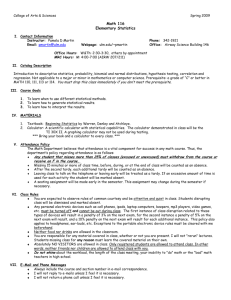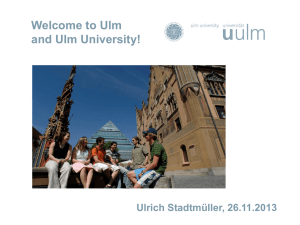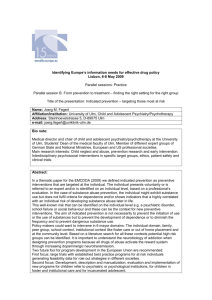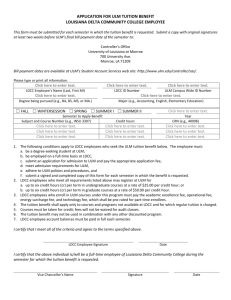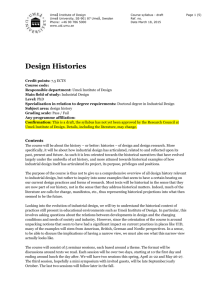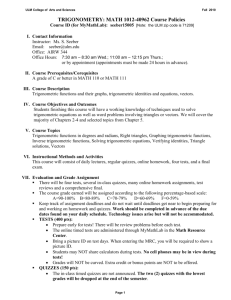ULM Time & Effort Reporting Guide
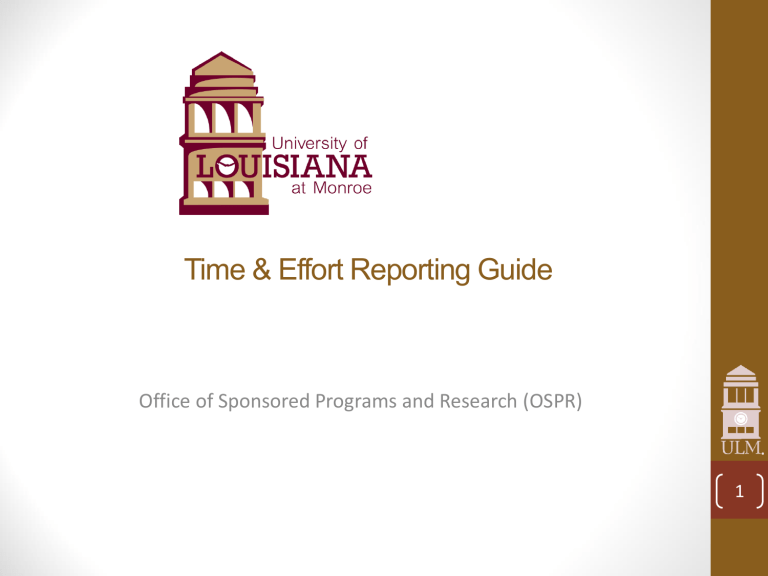
Time & Effort Reporting Guide
Office of Sponsored Programs and Research (OSPR)
1
Time and Effort Guide
Overview
• Completing the online ULM Time and Effort form
• Supplement Information:
•
Current Policy
•
Helpful Terms Related to Time and Effort
•
What to Consider When Effort Planning
•
About Personnel Cost Sharing at ULM
•
Federal Laws and Expectations
2
Completing the ULM Time and Effort form online https://webservices.ulm.edu/ospr/
ULM’s new online T&E reporting system aids all ULM employed individuals involved on a sponsored program/externally funded grant or project to complete their effort certifications. The new online reporting system provides information about effort for the timeframe of an entire year, but to meet federal requirements, everyone must confirm twice a year that the annual progress of effort has been on track (in other words, the report is reflective of the previous six-month period).
•
WHO:
• 1. The Principal Investigator (PI) has the responsibility to be the first to approve a report inclusive of all faculty/staff/student/employee’s effort as proposed on their grant project.
• 2. The Principal Investigator (PI) has the responsibility to complete the T&E forms for all student/GA/casual wage persons. This online T&E form is different than the ULM PI/faculty/staff persons form. This form is not populated with grant/project details. (Students/GA/casual wage individuals will not need to take any action to report effort.)
• 3. Each PI and ULM faculty/staff person is responsible for affirming their effort conducted on all externally funded grant/projects on their individual T&E Report form. For your individualized report, the grant/project(s) effort information (Section A and/or B) has been populated by OSPR and approved by the PI(s). You will complete
Section C of the report and submit.
• Note: If a faculty or staff employee is no longer working at ULM, it is the responsibility of the PI or Dean’s
Office to aid OSPR in completing their form.
• Additional note: contractors, subawardees or non-directly paid personnel through ULM’s payroll department do not complete a ULM T&E Report. These personnel are subject to T&E Reporting as required by their establishments.
3
Completing the ULM Time and Effort form online https://webservices.ulm.edu/ospr/
•
WHEN:
• The 2 revolving six-month reporting periods are:
• Report #1: If you actively worked on an externally funded grant/project during the time frame of
July 1 to December 31 (reporting due by January 31)
• PI’s first complete the T&E report inclusive of all ULM personnel (due between January 10 to January
23) – extended deadline March 14, 2014
• All other grant/project personnel complete the individual and/or student/GA/casual wage T&E forms
(due between January 24 to January 31)
– extended deadline March 31, 2014
• Report #2: If you actively worked on an externally funded grant/project during the time frame of
January 1 to June 30 (reporting due by August 31)
• PI’s first complete the T&E report inclusive of all ULM personnel (due between August 10 to August 23)
• All other grant/project personnel complete the individual and/or student/GA/casual wage T&E form
(due between August 24 to August 31)
• Note: At any point in the year, if a project or a person’s effort will not be on track in accordance with the timeline listed in the proposal, please notify the OSPR Office immediately. Actions may require adjustments in effort calculations and notification/renegotiation with the external funder.
4
Completing the ULM Time and Effort form online https://webservices.ulm.edu/ospr/
•
HOW:
• The PI Step-By-Step guide pg. 6 - 14
• How to complete the report inclusive of all faculty/staff/student/employee’s effort (pg. 6)
• How to complete the report for student/GA/casual wage persons (pg. 9)
• The (individual) PI, ULM Faculty/Staff Step-By- Step guide
• Including tips and considerations with examples pg. 15 - 22
5
Completing the ULM Time and Effort form online
HOW – PI’s Step-by Step guide:
• Step 1: Click on the link or go to the OSPR Grant Tracking Database webpage.
https://webservices.ulm.edu/ospr/
• Step 2: Log-in using your ULM (same as Zimbra) email username and password.
6
Completing the ULM Time and Effort form online
HOW – PI’s Step-by Step guide:
Step 3: Click on “ Certify
Reported Effort ” to review all externally funded grants/projects you oversaw as PI during the 6-month reporting period.
Note: If you see the notice “ No further certifications are required ” this can mean you were not a PI on an externally funded grant/project during the reporting timeframe, or you have already completed your report and no further action is needed.
7
Completing the ULM Time and Effort form online
HOW – PI’s Step-by Step guide:
(In this example there are two projects the
PI is reviewing.)
Step 4: Review the project(s) personnel, roles and annual effort %.
Note: “TBD” are students/GA/casual wage personnel. Make note or print this page in order to help complete the T&E report for these individuals. These workers constantly change so it is hard for us to include on this report for you. Effort for these individuals may be “0” because it was not determined at time of the proposal. Listing TBD personnel is an indicator for you to report their effort for this project on the student/GA/casual wage T&E forms – you will do this at another step.)
Step 5: After your review the information, choose “Certify” in the drop down box.
Step 6: Click “Submit Approvals”
Note: Do not certify unless all information is correct. If you find information that is not correct, please notify OSPR immediately to discuss. (“TBD” is ok to be blank or not complete. These individuals actual effort will be completed on their own form.)
8
Completing the ULM Time and Effort form online
HOW – PI’s Step-by Step guide:
Only if applicable - Step 7: Create a T&E report for each student/GA/casual wage individual.
Go back to “My Account” in the menu bar. Then Click on the last report.
9
Completing the ULM Time and Effort form online
HOW – PI’s Step-by Step guide:
T&E report for each student/GA/casual wage individual.
Step 8: Enter the person’s name and the type of employment they are classified as at ULM.
10
Completing the ULM Time and Effort form online
HOW – PI’s Step-by Step guide:
T&E report for each student/GA/casual wage individual.
• Step 9: Overload – For externally funded/sponsored grants/projects only. For students, this would be for work done outside of the academic year (i.e. summer). (Academic year –
Section B)
Leave blank if there is no overload/volunteered time to report.
Or
Enter each externally funded project the individual received paid overload or complete work on a voluntary basis during the 2013-2014 year.
Utilize a new box for every externally funded project.
Important: Enter annual effort % (or full project date range effort if less than a year) for each project.
11
Completing the ULM Time and Effort form online
HOW – PI’s Step-by Step guide:
T&E report for each student/GA/casual wage individual.
• Step 10: Grant/Project Work done as part of regular work responsibilities
Enter each externally funded project the student/GA/casual wage person received paid to work on an externally funded/sponsored grant/project during the 9 month academic year (summer is overload
– Section A).
Utilize a new box for every externally funded project the individual worked on during the
2013-2014 year.
Important: Enter annual effort % (or full project date range effort if less than a year) for each project. 12
Completing the ULM Time and Effort form online
HOW – PI’s Step-by Step guide:
T&E report for each student/GA/casual wage individual.
• Step 11: ULM work responsibilities
(Section C – If ULM also pays the individual to perform work for ULM – separate work than the grant/project)
Note: Use the “Other:” description block to explain any special considerations about effort from sections A, B, or C.
Leave Section C blank if there is no ULM work/effort to report.
Or
Enter effort for appropriate categories.
Important: Enter annual effort %
(or full project date range effort if less than a year) for each project.
13
Completing the ULM Time and Effort form online
HOW – PI’s Step-by Step guide:
T&E report for each student/GA/casual wage individual.
• Step 12: Certify and Save
Section B and C will be totaled together to reflect total annual effort for regular work responsibilities (not including overload/volunteered time).
Note: You can first preview the report before saving.
14
Completing the ULM Time and Effort form online
HOW – PI, ULM Faculty/Staff Step-by Step guide:
• Step 1: Click on the link or go to the OSPR Grant Tracking Database webpage.
https://webservices.ulm.edu/ospr/
• Step 2: Log-in using your ULM (same as Zimbra) email username and password.
15
Completing the ULM Time and Effort form online
HOW – PI, ULM Faculty/Staff Step-by Step guide:
Step 3: Click on “ Certify
Reported Effort ” to review all externally funded grants/projects you were involved in during the 6-month reporting period.
Note: If you see the notice “ No further certifications are required ” this can mean you did not work on an externally funded grant/project during the reporting timeframe, or you have already completed your report and no further action is needed.
16
Completing the ULM Time and Effort form online
HOW – PI, ULM Faculty/Staff Step-by Step guide:
Section A and B are prepopulated and certified by the PI.
Section A – Grant/Project work done outside of your regular work responsibilities - overload pay or volunteered time
Section B – Grant/Project work done as part of your work responsibilities - course-release or salary release time
Important Note: As you may recall, these sections are the same as the paper T&E reports done in the past. The main difference to the past form is that this report does not calculate effort for just the reporting period. Instead, you are certifying your annual effort on the project (based on the start and end dates of the project) and ensuring you were on track with your work/effort during the past six months.
17
Completing the ULM Time and Effort form online
HOW – PI, ULM Faculty/Staff Step-by Step guide:
• Step 3: Complete section C by entering your percent of effort associated with your ULM responsibilities.
Please review the next slides for all tips and considerations before completing this section.
18
Completing the ULM Time and Effort form online
HOW – PI, ULM Faculty/Staff Step-by Step guide:
Tips and considerations to complete Section C.
Tips:
• This report form is to track your base work load plus sponsored program/externally funded work. This report is not used to track overload pay or additional work done internally for ULM (i.e. course design, extra course instruction or endowments )
• It is most common for tenure and tenure-track 9-month faculty to have a workload of 60% instruction, 30% research and
10% services.
• It is common for tenure and tenure-track 12-month Pharmacy faculty to have a workload of 45% instruction, 45% research, and 10% service.
• It is common for department heads/chairs or deans to have a lesser percent of instruction and a designated percent of effort for administration
More considerations are on the next page…
19
Completing the ULM Time and Effort form online
HOW – PI, ULM Faculty/Staff Step-by Step guide:
Tips and considerations to complete Section C.
Considerations: Section B and C will be totaled together in the green area at the bottom of the form (after submission).
• If you are a part-time person, your total can be less than 100%. For example, if you worked on average 20 hours a week your effort total will be 50%, or if you worked approximately 10 hours a week your effort total will be 25%, etc.
• If you have no effort in Section B, your total should not exceed 100% (Section A, overload and volunteered time is not calculated in this total). Section C should be completed at 100% if you are a full-time employee, or less than 100% if you are a part-time employee.
• If your salary is fully funded at 100% by an external funder you will not enter any additional information in Section C.
• Your effort will total 100% in Section B if your grant/project(s) did not start or end at some point during the current reporting period.
• Or your effort will show a total over 100% in Section B if your grant/project(s) did start or end at some point during the current reporting period. This is because this online report form cannot calculate your effort for a partial year. To understand your annual effort is 100% the end and start dates of the grants/projects you were involved in during this reporting period must be taken into account. Therefore in this case it is ok to certify this report.
Ended 9/30/13
Started 10/1/13
More considerations are on the next page…
20
Completing the ULM Time and Effort form online
HOW – PI, ULM Faculty/Staff Step-by Step guide:
Tips and considerations to complete Section C continued…
Considerations: Section B and C will be totaled together in the green area at the bottom of the form (after submission).
• If you are a full-time person (9 or 12 month employee) and you have a grant/project effort listed in Section B, your total for Section B and C combined will total 100% annual effort. If this is the case, you will need to consider how much effort in Section B was for the past reporting period before you complete Section C.
For example: Section B has 3% annual effort listed for a full year or multi-year project, this is your total effort for that project for a year.
To complete Section C correctly:
60% instruction
27% research (3% already listed in
Section B as salary release time for research)
10% service
Therefore, your total for Section B & C
= 100%.
More considerations are on the next page…
21
Completing the ULM Time and Effort form online
HOW – PI, ULM Faculty/Staff Step-by Step guide:
Tips and considerations to complete Section C continued…
(This is the most complicated reporting scenario – but you can master this!)
You are a full-time person (9 or 12 month employee) and have other ULM commitments to list in Section
C (such as teaching, research, service, etc.) and you had a grant/project start or end at some point during this current reporting period. To reflect your annual effort at 100% total for Sections B & C, you must take into consideration how to calculate the grants/projects that were active or ended during this reporting period. With this online report form,
Section B (or A) cannot calculate your effort for a partial year for you. Therefore, you will notate and calculate your partial effort in Section C.
3
For this example we are reporting period #1 (effort that occurred July 1 to December 31) and there are two grants listed in Section B.
• The first grant was active for one year, October 1 to September 30, ending in the middle of this reporting period.
• The second grant started in October 1 but is active for two years.
Notate the partial effort change (what responsibility changed and when) due to the first grant ending, For this example, the research effort increased from 15% to 20% on 10/1. (You will not enter an effort number for this section because it already totals to 100%)
22
Time and Effort Guide
Supplement Information:
23
Current Policy
Definition: Time and Effort Reporting from Sponsored Program work conducted by ULM employees and students
• Time and Effort Reporting from Sponsored Program/Externally funded grants or projects work conducted by
ULM employees and students is employee’s affirmation that s/he indeed actually worked the amount of time promised in the awarded proposal of a sponsored program by documenting effort on the University’s Time and
Effort Report as required by Federal law.
ULM employee(s) commitment or person hired to work on a research/project for a sponsored program
For every reporting period, ULM employee(s) must report time spent on research/project for sponsored program and any other ULM responsibilities (teaching, services, administration, other).
Terms: Time and Effort Reporting from Sponsored Program work conducted by ULM employees and students
• 1. This policy applies to all ULM faculty/staff/students/employees who have worked on a sponsored project, regardless if they were paid by the sponsor or a match/cost share by ULM.
• 2. This policy does not apply to contractors, subawardees or non-directly paid personnel through ULM’s payroll department of the Controller’s Office. These personnel are subject to Time and Effort Reporting as required by their establishments.
• 3. The Time and Effort Report does not track overload pay for additional work done and paid by ULM (i.e. course design, course instruction, endowment, fellowship, etc.)
24
Current Policy
continued…
• Procedures: Time and Effort Reporting from Sponsored Program work conducted by ULM employees and students
Pre-Award
1. Salary amount(s) and effort percent(s) are calculated by the PI based on the scope of the research/project. The proposal must include the requested salary amount(s), including fringe benefit costs, to be paid by extramural funds or as a match/cost-share to the project.
• A. Contact the OSPR if you need assistance with salary amount and/or effort percent calculations. The ULM OSPR
Time and Effort Guidelines is posted on the OSPR website for reference.
2. Salary amount(s) and effort percent(s) must be approved internally via ULM Proposal Routing and Approving Forms http://www.ulm.edu/research/forms.html
.
Post-Award
1. Individuals responsible for Time and Effort reporting.
• A. The Principal Investigator(s) is responsible for retaining sufficient and adequate records (for a minimum of three years beyond the expiration date and/or closing date of the sponsored project) on all project records including tracking effort percent completed by all ULM employees and students for Time and Effort Reporting.
1. The Principal Investigator (PI) has the responsibility to be the first to approve a report inclusive of all faculty/staff/student/employee’s effort as proposed on their grant project.
2. The Principal Investigator (PI) has the responsibility to complete the T&E forms for all student/GA/casual wage persons. This online T&E form is different than the ULM PI/faculty/staff persons form. This form is not prepopulated with grant/project details. (Students/GA/casual wage individuals will not need to take any action to report effort.)
25
Current Policy
continued…
Post-Award (continued)
• B. Each PI and ULM faculty/staff person is responsible for affirming their effort conducted on all externally funded grant/projects on their individual T&E Report form. For the individualized report, the grant/project(s) effort information (Section A and/or B) has been pre-populated and approved by the PI(s). The PI, ULM faculty/staff member will complete Section C of the report and submit.
• Note: If a faculty or staff employee is no longer working at ULM, it is the responsibility of the PI or Dean’s
Office to aid OSPR in completing their form.
2. Time and Effort Reports must be completed by January 31 and August 31 of every year.
• A. The January 31 report must reflect all efforts conducted in the first half of the fiscal year - July 1 through
December 31. The August 31 report must reflect all efforts conducted in the second half of the fiscal year -January
1 through June 30.
• B. The OSPR office will generate Time and Effort Report information for each ULM faculty/staff/student/employee based on information supplied to the OSPR office by the PI (in the pre-award and post-award stages). It is important that PI’s keep the OSPR apprised of names of hires of employees or students in order to maintain a current reporting system.
3. If a project is not following the timeline listed in the proposal or employee effort has to vary for any circumstance, please notify the OSPR Office immediately. Actions may require adjustments in effort calculations and notification/renegotiation with the sponsored program.
26
Helpful Terms Related to
Time and Effort
continued…
• Sponsored Projects/Externally funded grants or projects involve a specific commitment of time and can be either:
1) externally funded activities in which a formal written agreement, such as a cooperative agreement, contract, or grant is entered into by ULM and by a sponsor for research, training, or other public service activities; or 2) internally funded for which the activities are separately budgeted and accounted for by ULM as a result of a formal application and approval process.
• Institutional Responsibilities those activities for which an individual is paid by ULM. Responsibilities can include administrative duties, instruction, research, and service.
• Effort is the amount of time spent on any activity expressed as a percentage of total institutional responsibilities for which an individual is compensated by ULM or sponsored program. Projected or committed effort and the employee’s actual effort must be commensurate with his/her responsibilities.
• Salary Recovery from Sponsored Program; also referred to as Buy-Out is faculty/staff salary payment to the university through extramural funding (from awards made to the university by a sponsored program - agencies and third parties - for research, instruction, or public service projects) in order to partially release the employee from university responsibilities (research, teaching, service, or administrative duties) so that the employee member can spend this portion of their time and effort on the awarded research/project.
27
Helpful Terms Related to
Time and Effort
continued…
• Effort Certification is the amount of time spent on any activity expressed as a percentage of total institutional responsibilities for which an individual is compensated by ULM. Time and Effort Certification reports are categorized into professional salaries, wages, sponsored effort, and residual effort. Total effort for all responsibilities together must equal 100% for full-time (9 or 12 month employees) or less than 100% for part-time employees. Time and Effort Certification reports and Payroll Distribution Records do not serve the same purpose.
Time and Effort Certification reports include total institutional responsibilities and reflect all committed effort and cost-sharing activities. Time and Effort Certification reports are based on a reasonable estimate by recognizing that teaching, research, and service are often inextricably intermingled.
• Institutional Base Salary is the total guaranteed annual compensation an individual receives from ULM whether the time is spent on research, service, or other activities.
• Appointment Period is listed on Appointment Letter at the time of hiring ULM faculty and staff on an annual basis.
The university operates on a modified semester system with two semesters during the academic year, three summer terms, and winter session. ULM employees are employed for selected semesters, Fall/Spring for 9-month faculty or by 10-month, 12-month and other time periods.
28
What to Consider When
Effort Planning:
• ULM requires that an individual’s total institutional responsibilities not exceed 100% within their appointment period (9-months, 10-months, academic year, etc.) and are consistent with his/her other duties (instruction, service, research and possibly administration).
• It is important to understand that effort is not calculated on a 40-hour workweek or any other standard workweek, but as a percent effort (up to full time = 100%) of set ULM responsibilities.
• Common Institutional Effort for Responsibilities:
• It is most common for tenure and tenure-track 9-month faculty to have a workload of 60% instruction, 30% research and 10% services.
• It is common for tenure and tenure-track 12-month Pharmacy faculty to have a workload of 45% instruction,
45% research, and 10% service.
• And it is common for department heads/chairs or deans to have a lesser percent of instruction and a designated percent of effort for administration. Therefore, tenure and tenure-track faculty tend to complete their sponsored program work as part of their research time. Those that need additional time to work on their sponsored project tend to have paid course-buy outs or conduct their sponsored project work outside of their appointed period.
• ULM allows employees to take on additional responsibilities outside of their appointed period (Maymester,
Summer I, Summer II, Wintersession, after work hours, etc.). All responsibilities, whether they are teaching overloads or sponsored programs, outside of the appointed period cannot exceed 30% above the employee’s institutional base salary.
• Also refer to student and Graduate Assistant policies on workload.
29
What to Consider When
Effort Planning: continued…
• ULM policy on minimum effort allows ULM employees to claim .5% committed effort for the sponsored program s/he is involved in. Exceptions to the minimum level of effort are for volunteered time outside of ULM responsibilities, equipment and instrumentation grants, doctoral dissertation grants, and augmentation grants. The minimum effort and the employee’s actual effort must be commensurate with his/her responsibilities.
• Department Heads/Chairs and Deans are limited to a maximum of 50% effort on sponsored projects during their appointment period. Faculty members, Deans, and Department Heads/Chairs may commit more effort when approved on a case-by-case basis by Academic Affairs.
• In the case of a training grant or other project which specifically restricts any salary charges, effort is recorded as voluntary uncommitted cost-sharing unless specifically required as a mandatory committed cost-sharing activity by the sponsor.
30
About Match/Cost Sharing at
ULM:
The ULM Policy on Cost Sharing requires that only the minimum amount required by the sponsor is allowed. Voluntary
Cost Sharing is discouraged unless the proposed Cost Sharing meets the University’s needs. Cost Sharing may be required by the sponsor or volunteered; however, any commitment of effort, whether solicited or volunteered, that is referenced in the awarded proposal must be honored, reported, and captured in the ULM Time and Effort Reporting system.
Pre-Award Stage
• During the Pre-Award stage, mandatory and voluntary cost sharing commitments are reviewed and approved by the Deans of the colleges as well as by personnel in the OSPR. When monetary cost sharing commitments are involved, each Department Chair, Dean, and respective Budget Authority must review, approve, and sign the actual account from which the monetary commitment is to be charged as part of the ULM Proposal Routing and
Approving Forms located at: http://www.ulm.edu/research/forms.html
.
Post-Award Stage
• When a notice of grant award is received (Post-Award stage) in which cost sharing was proposed, the cost sharing becomes a binding commitment that must be provided for and tracked in a consistent manner by the Principal
Investigator.
• All cost shared commitments are to be monitored and reported by the PI to the Grants and Contract Division of the ULM Controller’s Office for financial reporting. In addition, the OSPR Office must receive Time and Effort
Certification reports for each ULM faculty/staff/student/employee who is cost shared to the sponsor or paid by the sponsor.
• The Principal Investigator is responsible for notifying his/her supervisor of newly-awarded sponsored project that requires cost sharing commitments on behalf of the individual, the department, and/or the college. The PI is also responsible for notifying the OSPR Office of any changes in personnel or new hires for the project.
31
Federal Laws and
Expectations
• OMB Cir. A-21 Section J10 requires that a statement be signed by the employee, principal investigator or responsible official(s) using suitable means of verification that the work was performed.
• OMB Cir. A-21 J10 (a) notes that Incidental work (that is in excess of normal for the individual), for which supplemental compensation is paid by an institution under institutional policy, need not be included in the payroll distribution systems described below provided such work and compensation are separately identified and documented in the financial management system of the institution.”
• Would not consider work done as a paid consultant to another organization as part of the effort report.
• OMB Circular A-21 allows for a degree of tolerance. Certification must rely on a reasonable estimate of effort during a specified time period, and when estimating, a degree of tolerance is acceptable and appropriate.
• NIH Grants Policy Statement (FAQ) Rev. 10/12 http://grants.nih.gov/grants/policy/person_months_faqs.htm
• It is the statement of time actually worked on the specific project during the period versus the time that was budgeted for the project in the period.
• It is the employee’s affirmation that s/he indeed actually worked the amount of time promised in the proposal.
• The budgeted commitment is stated in the grant proposal.
• Provides verification of the appropriate amount of compensation charged directly to grants and contracts. Pay sources should reasonably reflect actual activity. Intentionally certifying effort incorrectly for personal gain can be viewed as fraud.
32
Federal Laws and
Expectations
Continued…
In other words…
• Effort Reporting is a reasonable estimate, not an exact science.
• Effort Reporting is a Federal Regulation to maintain compliance.
• Salary and wage charges to sponsored agreements are allowable only if they are supported/documented by an
Effort Reporting System.
• Late certification is a violation of University policy federal compliance requirements.
33
Questions?
Please contact us
Office of Sponsored Programs and Research
(318) 342-1039 ospr@ulm.edu
www.ulm.edu/research
34
